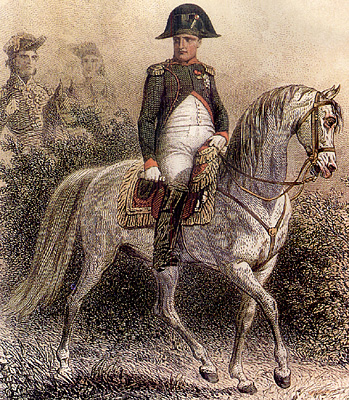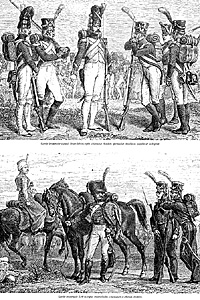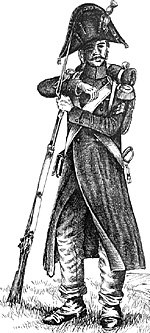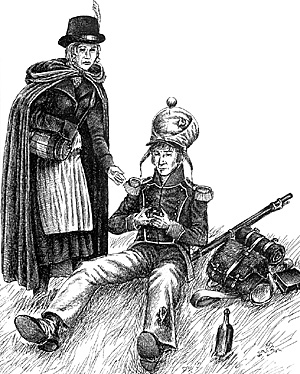 "La Garde Imperiale" was created on 18 May 1804. From its origins as a small personal escort, the Guard grew in size and importance. Eventually it became both the tactical and strategic reserve of the Grande Armee, comprising almost a third of Napoleon's field forces.
"La Garde Imperiale" was created on 18 May 1804. From its origins as a small personal escort, the Guard grew in size and importance. Eventually it became both the tactical and strategic reserve of the Grande Armee, comprising almost a third of Napoleon's field forces.
The men of the Imperial Guard were the e1ite of the First Empire, its officers the military aristocracy of post-revolutionary France. Such was its prestige that when the attacks of the Guard were repulsed at Waterloo they signalled not only the defeat of the French army but also the end of an era.
Napoleon's first guard unit was a company of mounted guides allocated to him as commander-in-chief of the Army of Italy in 1796. These men remained part of Napoleon's guard until his final abdication in 1815 and during the years of the Empire the duty squadrons of Chasseurs were sometimes still referred to as "guides". Bonaparte soon expanded this bodyguard to include two battalions of grenadiers and four companies of guides. The Guides followed Bonaparte to Egypt and two hundred returned to France with him in 1799.
On 10 November of that year Napoleon seized power with the aid of the grenadiers of the Guard of the Directory. Upon his appointment as First Consul, the Guard of the Directory became known as the Guard of the Consuls. From the very outset it was intended that the Consular Guard should be a model for the rest of the army:
"Admission will be restricted to men who have performed heroic actions, have been wounded, or have otherwise given proof ... in several campaigns of their bravery, patriotism, discipline, and exemplary conduct."
"They must be not less than twenty-five, between 1.78 and 1.84 metres in height, of robust constitution and exemplary conduct. They must have participated in three campaigns in the Wars of Liberty and know how to read and write."
The men received better pay, clothing, equipment and conditions than the rest of the Army. Each rank in the Guard also rated one step higher than its equivalent in the Line.
The Consular Guard consisted of:
- two battalions of Grenadiers a Pied
a company of light infantry
two squadrons of light cavalry
a company of Chasseurs a Cheval (formed from the Guides)
a company of light artillery including a detachment of horse artillery
fifty musicians
a general staff for a total of 2,089 men.
Following its success in the Marengo campaign in 1800, the Guard was increased to two battalions of grenadiers and one of foot chasseurs (Chasseurs a Pied). The cavalry contained two squadrons of horse grenadiers (Grenadiers a Cheval) and one of Chasseurs a Cheval. A train of twelve guns was attached to the artillery as well as an artillery park and a train company. The Guard continued to expand with the addition of a second battalion of Chasseurs a Pied and an extra squadron being added to each of the two cavalry regiments. It was necessary to ensure a steady flow of replacements and reinforcements for the Guard. Napoleon decreed that every year one man would be selected from each Line battalion and two from each cavalry and artillery regiment.
 Jumbo Garde Imperial Illustration (very slow: 264K)
Jumbo Garde Imperial Illustration (very slow: 264K)
This annual flow of men from the Line, however, proved to be insufficient to meet the Guard's requirements. Napoleon therefore introduced a cadet system to recruit ambitious young men into the ranks of the. Guard. These cadets were formed into two regiments, the Velite-grenadiers and the Velite-chasseurs. Their officers and NCOs were provided from men of the Grenadiers and Chasseurs a Pied.
Napoleon added a squadron of Mameluks to the Guard cavalry in 1802. In September 1803 a naval battalion - the Marins de la Garde was formed from survivors of the Battle of the Nile. By the time Napoleon crowned himself Emperor in May 1804, the now Imperial Guard numbered almost 10,000 men. Within a year this force was augmented by a regiment of gendarmes d'e1ite to police the Imperial residences.
On campaign the Guard provided the personal escort of the Emperor. The strength of the escort depended on the military situation and the proximity of the enemy, but one troop of cavalry always surrounded Napoleon's carriage. The escort dismounted at the same moment as the Emperor and encircled him. On the battlefield the duty squadron was mounted at all times, the Emperor being encompassed within their ranks, and in camp Napoleon's tents were protected by a cordon of Grenadiers or Chasseurs a Pied.
Considerable changes took place in 1806. Another cavalry regiment, Dragons de l'Imperatrice, was added to the Guard as well as a regiment of Fusiliers. The former took its men from the Dragoon regiments of the Line, whilst the Fusilier regiment was composed of velites stiffened with officers from the Chasseurs a Pied. It was also decreed that in times of war two companies of velites would march with each foot Guard battalion. In the same way, each squadron (of 250 men) would include fifty velites, and twenty-five velites were to be added to every artillery battery of 100 veteran gunners.
This increase in the proportion of younger troops being admitted to the Guard continued in 1807 with the formation of a regiment of Fusilier grenadiers which was raised from that year's conscription. A corps of guards of honour - the Gendarmes d'ordonnance - was recruited from sons of wealthy families who could afford to support themselves and provide their own mounts and equipment. That same year Napoleon's support for Polish independence led to the incorporation of a Polish cavalry regiment into the Guard. Following the Battle of Wagram in 1809 this corps adopted the lance as its principle weapon and in 1811 it became the 1er Regiment de Chevau-legers Lanciers, de la Garde.
In 1809 the Peninsular War and the war with Austria placed enormous demands upon France's resources. As a consequence the expensively paid and equipped senior Guard regiments were reduced in strength and more conscripts were added to the Guard. Along with the Fusilier-grenadiers there were now Fusilier-chasseurs, Tirailleur-grenadiers, Tirailleur-chasseurs, Conscrit-grenadiers and Conscrit-chasseurs.
In order to preserve the special status of the Old Guard these junior regiments were given the corporate title of the "Young Guard". The conscripts received only the pay of their counterparts in the Line.
 Sergeant of Grenadiers: Campaign dress 1812-15
Sergeant of Grenadiers: Campaign dress 1812-15
Despite the need for economy the Old Guard remained magnificently dressed and superbly appointed. Between 1806 and 1810 the Guard uniforms had cost Napoleon 20 million francs and the cost kept rising. The kit of a Chasseur a Cheval, for instance, called for five different kinds of cloth, two kinds of scarlet cloth, five qualities of woollen lace, and three types of yellow cord and gold braid. Their officers' tunics were heavily decorated in gold, with pelisses lined and edged in two types of fur, and their horses (all bays or chestnuts) were adorned with braided leopard skin shabraques.
In 1810 Louis Bonaparte renounced the throne of Holland and Napoleon absorbed the Kingdom of Holland into the French Empire, and many Dutch regiments were incorporated into the French Army. Some of these regiments joined the Guard. The NCOs and men of Louis' Garde du Corps became velites, one company of each being assigned to the Old Guard Grenadiers and Chasseurs. The Dutch Guard Grenadiers became the 2nd
Grenadiers of the Imperial Guard. The Hussars of Louis's Royal Guard became the 2nd Chevau-Ugers Landers - the famous Red Lancers - and the Dutch light artillery and train were included with the Imperial Guard Artillery. At the end of 1810 the Tirailleur-chasseurs and Conscrit-chasseurs were renamed "Voltigeurs of the Guard" and the regiments were numbered 1 to 4. The Tirailleur-grenadiers and Conscript-grenadiers became the "Tirailleurs of the Guard", also being numbered 1 to 4. The 5th and 6th Voltigeurs, and 5th and 6th Tirailleurs were created a few months later. The Fusilier-grenadiers and Fusilierchasseurs, now being relatively senior regiments, were allowed the general name "Middle Guard".
The expansion of the Guard and the transfer of veteran soldiers to command regiments of the Young Guard or the Line made the task of replenishing the Old Guard increasingly difficult. Replacements for the Young Guard came from selected conscripts, and Voltigeurs and Tirailleurs with two years' service and some education were chosen for the Fusiliers. The Old Guard found its recruits from NCOs and soldiers of the Line with ten years' service and good conduct records, and from Fusiliers with more than six years' service.
A similar arrangement was adopted for the Guard cavalry. The cavalry regiments were expanded to five squadrons each and organised into one "light" division and one "heavy" division, both divisions containing 3,000 men. The hussars, chasseurs and lancers of the Line replenished the light division, replacements for the heavy division being furnished by the carabiniers, cuirassiers and dragoon regiments of the Line.
On the eve of 1812 the Guard totalled thirty regiments and in that year their seniority was officially classified as follows:
Old Guard
- All officers of the 1st, 2nd and 3rd Grenadiers a Pied, 1st and 2nd Chasseurs a Pied
- All officers of the Chasseurs and Grenadiers a Cheval, Dragoons, Lancers and Mamelukes
- All officers of the Artillerie (a cheval and a pied) Pontonniers, Sapeurs du G6nie, Train d'artillerie and the Marines
- Colonels, Majors and Captains of Voltigeurs, Tirailleurs, Flanquers and the Garde-National de la Garde.
- NCOs and men of the 1st Chasseurs and 1st Grenadiers a Pied
- NCOs of the 2nd Grenadiers and Chasseurs
- NCOs of the Fusiliers
- All ranks of the Grenadier and Chasseurs a Cheval, the Dragoons, the 1st Lancers, Mameluks, elite Gendarmes, foot and horse artillery, pontooneers, sappers, and marines
- NCOs only of the horse artillery attached to the Young Guard.
Middle Guard
- All other ranks of the 3rd Grenadiers, 2nd Lancers, Fusiliers, artillery train, the Italian velites, and the Ouvriers d'Administration
- Corporals (Brigadier-soldats) and men of the 2nd Chasseurs and 2nd Grenadiers a Pied.
Young Guard
- All other ranks of the Voltigeurs, Tirailleurs, Flanquers, National Guards, and the train battalion
- Corporals and gunners of the artillery attached to the Young Guard.
For the Russian campaign of 1812 the Imperial Guard formed a complete army corps over 35,000 strong, containing three infantry divisions with supporting artillery, a cavalry division and a reserve artillery park. This magnificent force, however, perished in the barren Russian wastes. Little more than 3,000 men survived the retreat from Moscow but the spirit of the Guard lived on in those that were left. It was around this tiny band of survivors that Napoleon was to build a new army. In the Guard depots were some 8,000 conscripts called up the previous September.
These, with a further levy of 10,000 men, would form the nucleus of the Young Guard. They would be stiffened with experienced men from the National Guard and the 3rd Voltigeurs and 3rd Tirailleurs who had been serving in Spain. Despite the loss of so many veterans Napoleon insisted on maintaining the high entry standards of the Old Guard. Officers and NCOs were required to have twelve years' service and to have served in several campaigns, and other ranks ten years' service. The former regiments were reformed.
With additional conscripts Napoleon was able to increase both the Voltigeur and Tirailleur regiments to thirteen. Each cavalry regiment was expanded to a brigade containing one Old Guard and one Young Guard regiment. A company of artillery was attached to each infantry brigade and there was a further four reserve batteries with thirty-two 12-pounders or long barrelled howitzers, giving the Guard artillery a total of 196 guns.
Still the Guard continued to grow. By the middle of August 1813 the Guard included 35,000 infantry, 8,000 cavalry, and 200 guns. The Old Guard Division contained the 1st and 2nd Grenadiers and the 1st and 2nd Chasseurs a Pied, with two battalions of velites. The Young Guard was organised into four divisions each one containing five regiments of voltigeurs or Tirailleurs. The 1st Young Guard Division also included the two regiments of Fusiliers, and the 2nd Division included two battalions of Flanquers. The cavalry was formed into a light division containing the Polish, Dutch and Berg lancers, and a heavy division consisting of 1,500 Chasseurs, 1,200 Dragoons, 1,200 Grenadiers, and 500 Gendarmes d'Elite.
With Napoleon's abdication in 1814 the Guard was disbanded. Many old soldiers were pensioned off and others were either discharged or dispersed around the other regiments of the Army. A token force, the Elba Battalion, accompanied Napoleon into exile. This battalion was composed of a staff and six companies, totalling 607 Grenadiers and Chasseurs a Pied. The cavalry numbered just 118 of which there were seven Chasseurs and Mamelukes, the rest being Polish lancers. There was also a crew of twenty-one marines.
 Private, Tirailleurs of the Imperial Guard and Cantiniere - 100 Days Campaign
Private, Tirailleurs of the Imperial Guard and Cantiniere - 100 Days Campaign
Shortly after his return to power in 1815 Napoleon reconstituted the Guard. Again strict entry standards were set. A minimum of twelve years' service was the requirement for entry into the infantry of the Old Guard, and eight for the cavalry and artillery. Four years' service was stipulated for the Young Guard. The Grenadier corps was to consist of the 1st, 2nd and 3rd Grenadiers and six Tirailleur regiments, and the Chasseurs of three Old Guard regiments and six regiments of Voltigeurs. The cavalry regiments - The Grenadiers, Chasseurs, Dragoons, and Lancers - were each composed of four squadrons. A single company of Gendarmes was also raised. The artillery was to comprise six foot and four horse companies, with a company of artificers and eight train companies.
By the time of the Waterloo campaign a 4th regiment of Grenadiers and of Chasseurs; had been raised as well as the 7th and 8th regiments of Tirailleurs and Voltigeurs. This gave Napoleon eight Old and Middle Guard regiments and sixteen Young Guard regiments.
At Waterloo the Young Guard was ordered to hold back the advance of the Prussians. The Middle Guard marched against the centre of British positions in a final, desperate attempt to break Wellington's line. But the Guard was driven back, and when the cry of "La Guard recule!" reverberated through the ranks of the French army the men turned and fled. It was the end of a legend, and the end of the Napoleonic Wars.
Back to Age of Napoleon 18 Table of Contents
Back to Age of Napoleon List of Issues
Back to MagWeb Master List of Magazines
© Copyright 1996 by Partizan Press.
This article appears in MagWeb (Magazine Web) on the Internet World Wide Web.
Other military history articles and gaming articles are available at http://www.magweb.com